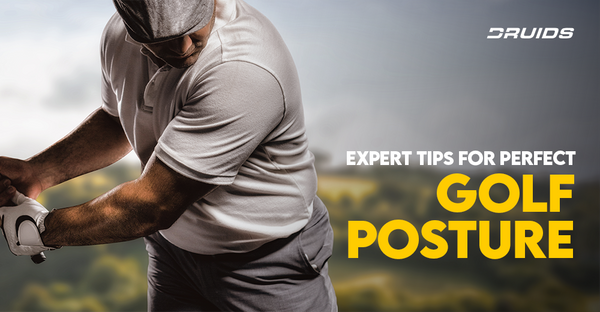When starting out as a golfer, it is crucial to learn the correct golf stance. A well-balanced golf stance is the key to delivering consistent and powerful swings- meaning if your stance is not correct, chances are, your ball won't cover long distances, and you will struggle to hit it along the target line.
Also Check: How To Improve Golf Swing — Easy Tips To Improve At Golf.
A good golf stance has various elements, including the golf grip, the distance between your feet, overall posture, and alignment. Let's dissect these elements one by one, so next time you step on the greens, you are prepared to swing and strike like a pro.
Golf Alignment:
Golf alignment refers to the positioning of a golfer's body and clubface in relation to the line of target. The alignment in golf has three major components, each of which is important in achieving powerful and consistent strikes.
1- Clubface Alignment
Most amateur golfers struggle to align the clubface with their target. Luckily, with proper guidance and practice, one can quickly master it. Here are some easy pointers you can follow to attain perfect clubface alignment.

-Identify the target or the place where you want your ball to land. Your target can be a point on the fairways, the centre of the greens or a specific hole.
-Next, stand behind the golf ball and imagine a line running along the ground from your target to the ball. If you struggle with visualisation, you may use an alignment stick during practice.
-Now hold the club in your hands with a neutral grip and align the club face with the target line. Pay attention to the bottom groove of your golf club and angle it at 90 degrees to your target line. This perpendicular alignment to the target line is called square clubface, which will help you produce straighter shots.
2- Body Alignment
You need to align your body parallel to the target line to ensure it aims in the direction you want the ball to travel. Always remember that in golf, your feet, hips, shoulder, and knees work in sync to produce good golf shots. To align your body perfectly and efficiently, follow the following steps:

- Once your club aligns with the line of target, position your trail foot in a way that matches the leading edge of the clubhead and place it there.
-Once you've comfortably positioned your trail foot, put your lead foot next to it and ensure both feet are in a perfect line.
-To make sure that the lead foot isn't higher or lower than the trail foot, pay attention to your toes and ensure they line up.
-When you set up for a golf shot, the position of your lead foot has a great impact on your shoulder's alignment- meaning your lead foot influences whether your shoulders end up being square, open, or closed.
-In a closed stance, the toes of your lead foot point toward your trail foot and lead to shots veering to the left (for a right-handed golfer). On the other hand, when the toes of your lead foot are pointing away from your trail foot, it's called an "open stance" and results in shots curving to the right.
So when your toes line up correctly, your shoulders align parallel to the target line (square stance) and ensure straight and accurate shots.
-Next comes the alignment of your hips and spine. Maintain a straight, comfortable spine angle, bend slightly at the hips while keeping your back relatively straight.
3- Ball Position

The ball's position in relation to your golf club influences trajectory, distance, and accuracy of your shots. Here is a comprehensive explanation of ball positioning to help hit your desired shots and develop a versatile and adaptable game on the golf course.
Wedges and Short Iron: For wedges and 7-irons, place the ball in the centre of your stance to ensure crisp contact and desired trajectory.
Mid Irons: For mid irons (5-7), position the ball a little ahead of the centre. Take the width of your ball as a reference and move the ball half or full-width forward from the centre.
Long Irons: For long irons (3-4), move the ball towards your front (lead foot). It will help you counteract the lower loft and create better launch conditions.
Driver: For the driver, position the ball closest to your front (lead) foot- just inside the heel to allow the ball to cover maximum distance at a higher launch angle.
Fairway Woods and Hybrids: For fairways and woods, place the ball ahead of the centre. One to two ball widths forward from the centre would be ideal for these clubs.
Also Check: Comprehensive Guide To 3 Wood Golf Club.
Golf Posture:
Golf posture is the foundation upon which a successful swing is built. So if you aim to master the art of swinging, begin by nailing your golf posture. At first, keeping that perfect posture might feel like a challenge, but the good thing is, it's not impossible. With our tips and consistent practice, you can fine-tune your posture and swing smoothly on the greens.
Here are a few pointers you can follow to attain the ideal golf posture:
-In your mind, visualise how you would position your body when bouncing a basketball. For golfing, you need to hold the same posture.
-Stand up straight with your legs shoulder-width apart. Your feet should be in a neutral position, with toes neither pointing outwards nor inwards.
-Push your shoulders back and puff out your chest.

-While keeping your spine straight, bend your upper body over from your hips, think of it like pushing your hips back into a chair. You need to bend just enough for your golf club to touch the greens. Keep in mind that your back must remain straight throughout. Bend your knees slightly as the club touches the ground. This will stabilise you and keep your feet rooted on the ground during the swing.
-Keep your chin up and head in line with your back. If you have any trouble moving your head or looking at the ball, you may have lifted your head too much.
-Practise your posture setup repeatedly, and over time, you'll be able to refine your posture to suit your swing style and body type.
In short, a good golf posture calls for the back straight, hips out, shoulders pushed back, and head up.
Width Of Stance:
The distance between your feet impacts your body's stability and balance throughout the swing. Depending upon the length of your club, swing style, and body type, you may have to narrow down or widen the stance to ensure a blend of power and control in your shots.
Types Of Golf Stance
Normal Stance

The normal golf stance is the one where your feet are shoulder-length apart. In more precise words, in a normal stance, the outer edge of your shoulders aligns with the middle of your feet. The normal stance is an athletic position implied widely to play golf shots on the course.
Wide Stance

In a wide stance, your feet are further away than they are in a normal stance. In other words, the outer edge of your shoulders aligns with the inner side of your feet in a wide stance. This stance improves stability during the swing, making it preferable for windy conditions and uneven terrains.We recommend you adopt a wide stance when playing with long clubs- especially the driver or fairway wood.
Narrow Stance

The narrow golf stance is the one where your feet placement is slightly narrower than the normal stance. In other words, the outer edge of your shoulders lines up with the outer side of your shoes in this type of stance.
A narrow golf stance improves your ability to rotate and allows the ball to travel straighter. The downside of the narrow golf stance is that it makes your feet less stable, hence the reason it is only preferred for smaller clubs and shorter swings.
Grip On The Golf Club:
A good golf swing depends on a good grip on the golf club. This statement may sound like an exaggeration, but considering that most golf coaches do not move forward with the training until their student masters their club grip should be enough reason to believe and work on your grip. It doesn't matter if you are an amateur or professional golfer- our tips will help you improve your grip on the club and your swing.
-Pick up your golf club with your weaker hand- for right-handed golfers it's their left hand, and for left-handed golfers their right hand.
-Turn your hand slightly clockwise (for right-handed golfers) or counterclockwise (for left-handed golfers) so you can see the back of your hand facing you. This rotation ensures correct positioning for your weaker hand on the grip.
-Now look down at your hand and see if two knuckles are visible to you, if yes, you have positioned your hand correctly. The V-shape formed by your thumb and index finger should be pointing towards your right shoulder (for right-handed golfers) or left shoulder (for left-handed golfers). This positioning will allow you to move your wrist freely and comfortably and help maintain a square clubface.
-Now take your lead hand (right for right-handed golfers and left for left-handed golfers) and grip the club with your lead thumb overlapping your other thumb. Make sure that your lead thumb points downwards and rests along the left side of the club grip for right-handed golfers and vice versa.
-If it's your first time practising golf grip and you aren't confident about your hand positioning, worry not. You can always use mould grip trainers to help you grip the club in the right places and ensure powerful strikes.
Also Check: Guide To World's Best Golf Academies & Schools.
Last Word:
If you are tired of playing awful shots and want to hit birdies on every hole, start from the beginning- meaning correct your golf posture. Every tip in this article will help you enhance your golf skills, and you will be grateful for following it. So don't wait up. Put on your favourite golf polo shirt and golf trousers, grab your equipment and get ready to imply all you've read on the golf course.




